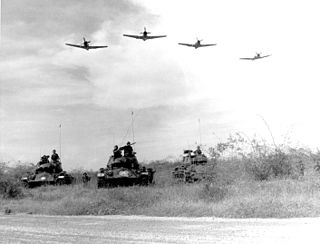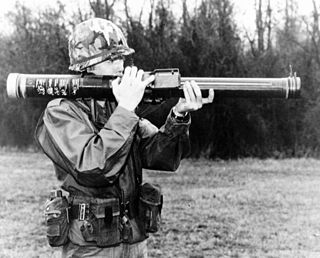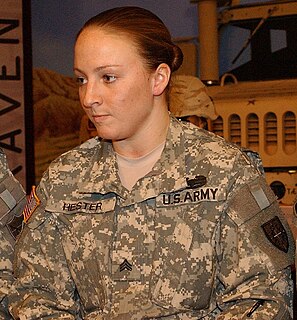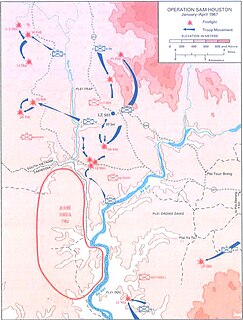
An ambush is a long-established military tactic in which combatants take advantage of concealment or the element of surprise to attack unsuspecting enemy combatants from concealed positions, such as among dense underbrush or behind hilltops. Ambushes have been used consistently throughout history, from ancient to modern warfare. In the 20th century, an ambush might involve thousands of soldiers on a large scale, such as over a choke point such as a mountain pass, or a small irregular band or insurgent group attacking a regular armed force patrol. Theoretically, a single well-armed and concealed soldier could ambush other troops in a surprise attack. Sometimes an ambush can involve the exclusive or combined use of improvised explosive devices, that allow the attackers to hit enemy convoys or patrols while minimizing the risk of being exposed to return fire. Tranquilizer guns, tasers, and knockout gas grenades are not generally used in ambush.

Infantry is an Army specialization whose personnel often engage in Military combat. They operate weapons and equipment to engage and destroy enemy ground forces. Infantry generally consists of light infantry, mountain infantry, motorized infantry, marine infantry, mechanized infantry or airborne infantry. It is considered to be one of the most physically demanding and psychologically stressful military jobs.
Military tactics encompasses the art of organizing and employing fighting forces on or near the battlefield. They involve the application of four battlefield functions which are closely related – kinetic or firepower, mobility, protection or security, and shock action. Tactics are a separate function from command and control and logistics. In contemporary military science, tactics are the lowest of three levels of warfighting, the higher levels being the strategic and operational levels. Throughout history, there has been a shifting balance between the four tactical functions, generally based on the application of military technology, which has led to one or more of the tactical functions being dominant for a period of time, usually accompanied by the dominance of an associated fighting arm deployed on the battlefield, such as infantry, artillery, cavalry or tanks.

Combined Arms is an approach to warfare which seeks to integrate different combat arms of a military to achieve mutually complementary effects. According to strategist William S. Lind, combined arms can be distinguished from the concept of "supporting arms" as follows:
Combined arms hits the enemy with two or more arms simultaneously in such a manner that the actions he must take to defend himself from one make him more vulnerable to another. In contrast, supporting arms is hitting the enemy with two or more arms in sequence, or if simultaneously, then in such combination that the actions the enemy must take to defend himself from one also defends himself from the other(s).

In military operations, reconnaissance or scouting is the exploration of an area by military forces to obtain information about enemy forces, terrain, and other activities.

Paintball is a competitive team shooting sport in which players eliminate opponents from play by hitting them with spherical dye-filled gelatin capsules called paintballs that break upon impact. Paintballs are usually shot using low-energy air weapons called paintball markers that are powered by compressed air (nitrogen) or carbon dioxide and were originally designed for remotely marking trees and cattle.

Friendly fire or fratricide in military terms is an attack by belligerent or neutral forces on friendly troops while attempting to attack enemy/hostile targets. Examples include misidentifying the target as hostile, cross-fire while engaging an enemy, long range ranging errors or inaccuracy. Accidental fire not intended to attack enemy/hostile targets, and deliberate firing on one's own troops for disciplinary reasons, is not called friendly fire, and neither is unintentional harm to civilian or neutral targets, which is sometimes referred to as collateral damage. Training accidents and bloodless incidents also do not qualify as friendly fire in terms of casualty reporting.

A combat engineer is a type of soldier who performs military engineering tasks in support of land forces combat operations. Combat engineers perform a variety of military engineering, tunnel and mine warfare tasks as well as construction and demolition duties in and out of combat zones.

Anti-tank warfare originated from the need to develop technology and tactics to destroy tanks during World War I. Since the Triple Entente developed the first tanks in 1916 but did not deploy them in battle until 1917, the German Empire developed the first anti-tank weapons. The first developed anti-tank weapon was a scaled-up bolt-action rifle, the Mauser 1918 T-Gewehr, that fired a 13mm cartridge with a solid bullet that could penetrate the thin armor of tanks of the time and destroy the engine or ricochet inside, killing occupants. Because tanks represent an enemy's greatest force projection on land, military strategists have incorporated anti-tank warfare into the doctrine of nearly every combat service since. The most predominant anti-tank weapons at the start of World War II in 1939 included the tank-mounted gun, anti-tank guns and anti-tank grenades used by the infantry, as well as ground-attack aircraft.

Urban warfare is combat conducted in urban areas such as towns and cities. Urban combat differs from combat in the open at both the operational and the tactical levels. Complicating factors in urban warfare include the presence of civilians and the complexity of the urban terrain. Urban combat operations may be conducted to capitalize on strategic or tactical advantages associated with the possession or the control of a particular urban area or to deny these advantages to the enemy.

Close-quarters combat (CQC) or close-quarters battle (CQB) is a tactical situation that involves a physical fight with firearms involved between multiple combatants at quite short range. It can occur between military units, police/corrections officers and criminal elements, and in other similar situations. In warfare, it usually consists of units or teams of varying size engaging the target or attacking personnel with personal weapons within a distance of up to 100 meters, from proximity hand-to-hand combat to close-quarter target negotiation with usually automatic weapons. In the typical close combat scenario, the attackers try a very fast, violent takeover of a vehicle or structure controlled by the defenders, who usually have no easy method to withdraw. Because attacking and defending personnel, hostages/civilians, and friendly personnel can be closely intermingled, close-quarters combat demands a rapid assault and a precise implementation of lethal force. The operators need obvious, sufficient proficiency with their weapons, and the ability to make quick decisions in order to limit friendly casualties and raise the likelihood of operational success.

Insurgency weapons and tactics are weapons and tactics, most often involving firearms or explosive devices, intended for use by insurgents to engage in guerrilla warfare against an occupier, or for use by rebels against an established government. One type of insurgency weapon are "homemade" firearms made by non-professionals, such as the Błyskawica (Lightning) submachine gun produced in underground workshops by the Polish resistance movement. Another insurgency weapon is a sanitized weapon, which is a weapon of any sort that has had normal markings, such as the manufacturer's name and/or serial number, omitted or obscured in an attempt to hide the origin of the weapon.

Leigh Ann Hester is a United States Army National Guard soldier. While assigned to the 617th Military Police Company, a Kentucky Army National Guard unit out of Richmond, Kentucky, Hester received the Silver Star for her heroic actions on 20 March 2005 during an enemy ambush on a supply convoy near the town of Salman Pak, Iraq.

Infantry tactics are the combination of military concepts and methods used by infantry to achieve tactical objectives during combat. The role of the infantry on the battlefield is, typically, to close with and engage the enemy, and hold territorial objectives; infantry tactics are the means by which this is achieved. Infantry commonly makes up the largest proportion of an army's fighting strength, and consequently often suffers the heaviest casualties. Throughout history, infantrymen have sought to minimise their losses in both attack and defence through effective tactics.
Tank desant is a military combined arms tactic, where infantry soldiers ride into an attack on tanks, then dismount to fight on foot in the final phase of the assault. Note that this differs from infantry troops merely riding on tanks as a form of ad-hoc transportation. Desant is a pan-Slavic general term for airborne or parachute drops and naval infantry amphibious landing operations.

Operation Conservation was an attempt by the British Army to ambush a large Provisional Irish Republican Army (IRA) unit along the Dorsey Enclosure, between Cullyhanna and Silverbridge, in south County Armagh. The action took place on 6 May 1990 but was thwarted by the South Armagh Brigade of the IRA.

VC and PAVN battle tactics comprised a flexible mix of guerrilla and conventional warfare battle tactics used by Viet Cong (VC) and the North Vietnamese People's Army of Vietnam (PAVN) to defeat their U.S. and South Vietnamese (GVN/ARVN) opponents during the Vietnam War.

Operation Sam Houston was a US Army operation that took place in the Plei Trap Valley and around Plei Doc, lasting from 12 February to 5 April 1967.

The Battle of the Slopes was the site of an engagement between elements of the 173rd Airborne Brigade (Separate), nicknamed "Westmoreland's Fire Brigade" and People's Army of Vietnam (PAVN) units, as part of Operation Greeley.

















